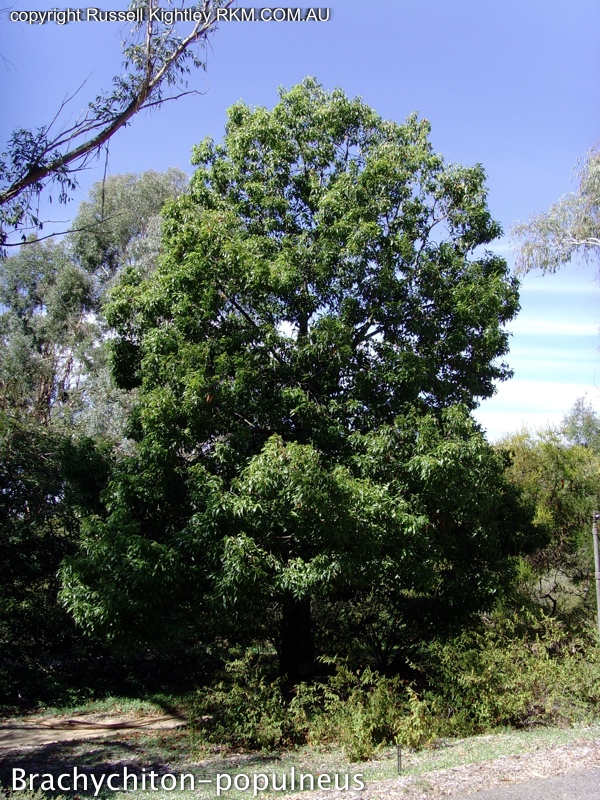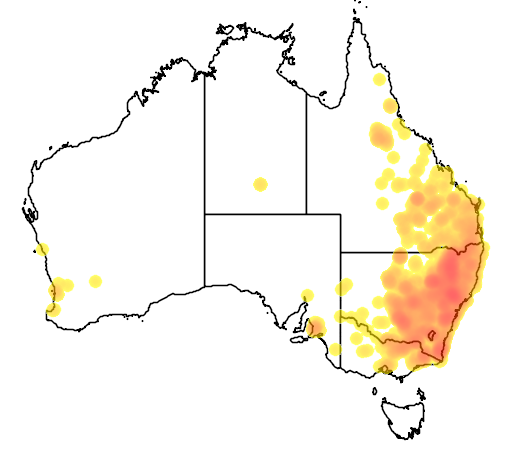Description
Common names
Kurrajong, Currajong, Kurrajong Tree.
Scientific names
Brachychiton populneus, Sterculia diversifolia.
Family
Sterculiaceae.
Genus
Brachychiton.
Name origin
Brachychiton, from Greek brachys, short, and chiton, under-garment or outer covering, referring to loose outer covering of seeds. Populneus, from Latin populnus, poplar-like, referring to similarity of adult leaves to those of European poplar.
Rainfall
350mm.
Growth rate
Slow, moderate.
Growth height
Up to 20m.
Presence in Australia
Widespread through entire area, although possibly not indigenous in western areas.
This specie has been identified in the following Australian states: Qld, NSW, ACT, Vic, SA, NT, WA.
Habitat
Forest and woodland.
Habit
Evergreen tree to 20m high. Strongly tapering trunk and dense crown.
Site preference
Well-drained soil. Drought tolerant. Sensitive to frost when young. Tolerates alkaline soil.
Characteristics
Slow-growing until 3 years, after which tends to grow more rapidly. Very long-lived.
Flowering
Creamy-white and speckled with dark red, usually Mar-Dec.
Seed collection
Early Jul to late Jan. Seeds released 3-14 days after maturity. Hairs in pods can irritate.
Propagation
From seed (±8 viable seeds per gram). Enhance germination by soaking seeds in hot water for 12 hours before sowing. Sow into large pots or 1 litre milk cartons, or in beds of loamy soil in spring. These will be large enough to transplant to temporary beds the following winter. Plant seedlings 15cm apart in rows 60cm apart. By the next winter, seedlings should be over 60cm high, and can be transplanted to final site. Seedlings to over 2m high transplant readily.
Regeneration
From seed dispersed by birds.
Shade and shelter
Excellent shade. Can be planted in clumps for this purpose. Useful medium-level cover in windbreaks.
Land protection
Suitable for recharge control.
Timber
Light, soft and creamy-hued, with open texture and interweaving definite ray-grain, giving a silken sheen. Not strong or durable. Density about 450 kg/m3. Rarely utilised, although has been used for lattice construction and interior furnishings.
Wildlife
Nectar-feeding birds and insects attracted to flowers.
Koori
String and fishing nets made from fibrous bark. Water extracted from roots. Seed roasted and eaten (after removing irritating hairs), or eaten raw. Uniquely flavoured, highly palatable flour produced by roasting and milling cleaned seed. Yam-like tuberous roots of young plants were eaten. Grubs eaten.
Ornamental
Attractive shapely tree for gardens, parks and avenues. Forms larger crowns if pruned when young.
Other
Excellent drought fodder for sheep and cattle. Responds well to occasional moderate lopping. Foliage highly palatable and nutritious, and trees have high ratio of leaf to wood. Due to deep tap roots, Kurrajongs do not compete with crops or pastures, and are not damaged by cultivation close to trunk. Seeds can be roasted, ground and briefly boiled as coffee substitute. Can be grown for edible seed crop, planted at 275 trees per hectare (at 6m spacing). Leaves produce orange, gold and lemon coloured dyes depending on mordant used.


